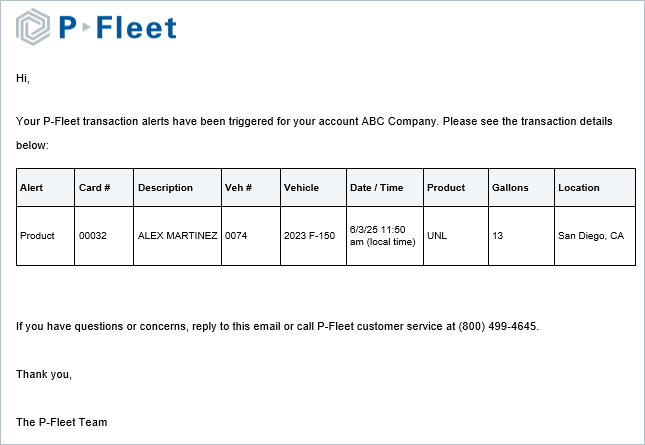
Keeping fuel costs under control starts with knowing exactly how much fuel your fleet is using and where it’s going. For most businesses, fuel is one of the largest operating expenses, and if you’re not monitoring it closely, you could be losing money to theft, vehicle issues, or inefficient driving without even realizing it. That’s where tracking fuel consumption with a fleet fuel card makes all the difference.
In this guide, we’ll cover why monitoring fuel usage is so important, the different tools fleets use to track it, and a step-by-step walkthrough on how to monitor your fleet’s fuel consumption with a fuel card. By the end, you’ll know how to spot inefficiencies, protect your fuel spend, and make better decisions to keep fuel expenses in check.
Table of Contents
- Why is it important to monitor fleet fuel consumption?
- What are the different tools for monitoring fleet fuel consumption?
- How to monitor fleet fuel consumption with a fuel card: step-by-step
Why Is it Important to Monitor Fleet Fuel Consumption?
Fuel is one of the biggest expenses for any fleet, and if you’re not tracking it closely, you could be losing money without even realizing it. Issues like driver fuel theft, underperforming vehicles, or poor driving habits can quietly drive costs up. And even if you know fuel costs are higher than they should be, without monitoring fleet fuel consumption you won’t know what’s causing it or how to fix it. By tracking your fuel spend, you’ll be able to:
- Prevent theft and misuse: When you use a fleet fuel tracking system for your fleet, it's easier to prevent and spot suspicious transactions or unauthorized fuel use.
- Spot inefficiencies early: Low MPG data can point to problems like underperforming vehicles, excessive idling, or aggressive driving habits so you can fix them to reduce expenses.
- Easier accounting: Fuel data is organized into clear reports and invoices, cutting out the hassle of chasing receipts or manually entering transactions.
- Simplified compliance: Tracking fuel consumption provides the data you need for IFTA reporting and other compliance requirements without the headache of manual recordkeeping.
What Are the Different Tools for Monitoring Fleet Fuel Consumption?
The tools you use to track fleet fuel will depend on your fleet size, fueling habits, and how you operate. The most common options: fuel cards, GPS systems, bulk tank monitoring, and mobile fuel delivery, each give you different ways to monitor usage and keep costs under control.
Fleet Fuel Card
A fleet fuel card works like a credit or debit card at the pump, but it’s built specifically for businesses to manage fuel spend. Drivers can use them at gas stations, truck stops, and cardlock sites, while managers can monitor fleet fuel consumption with built-in spend controls, detailed fuel reports, and consolidated invoices. Since purchases are restricted to fuel, you don’t have to worry about company money being spent on non-fuel items.
Fleet GPS system
A fleet GPS system monitors fleet fuel consumption by pulling data straight from your vehicles’ OBD-II system. It monitors things like MPG, idle time, and driving habits, then combines that with GPS location data to show how efficiently your fleet is running.
With this setup, you can see if fuel is being wasted on excessive idling, aggressive driving, or inefficient routes. Many GPS systems also integrate with fuel cards, letting you compare gallons purchased vs. gallons actually consumed. That means you get a clearer picture of fuel usage, spot issues faster, and take action to cut costs.
Bulk Fuel Tank Monitoring System
Some larger fleets install on-site bulk fuel tanks at their yards, creating a private fueling station for their vehicles. With pumps hooked directly to the tanks, drivers can fill up on-site, saving time and avoiding fuel stops. Buying fuel in bulk also cuts costs since larger deliveries usually come with a lower price per gallon. To keep usage in check, many fleets add bulk tank fuel monitoring software and hardware, which tracks every gallon by driver and vehicle. That extra visibility gives managers more control and better reporting over fuel expenses.
Mobile Fuel Delivery
Mobile fuel delivery, sometimes called on-site fueling or wet hosing, is when a fuel truck comes to your yard and fills vehicles one by one. Each vehicle gets a unique barcode sticker, and the driver scans it before pumping to track gallons for that unit. From there, you get portal access to see fuel usage by vehicle and run detailed reports.
How to Monitor Fleet Fuel Consumption with a Fuel Card: Step-by-Step
By setting up fuel cards the right way, adding spend controls, requiring accurate odometer entries, using purchase alerts, and reviewing reports, you’ll get full visibility into your fleet’s fuel usage. This helps you spot inefficiencies, prevent theft, and keep fuel costs under control. Follow these steps to monitor fleet fuel consumption with a fuel card.
Step 1: Choose Your Fuel Card Assignments
The way you set up your fuel cards is the foundation for tracking fleet fuel consumption. To get accurate data, you need to capture both driver and vehicle info with every fill-up. There are two main ways to assign cards:
- Assign to driver with PIN: The driver’s name is printed on the card, and each transaction requires a PIN. This setup works best when drivers always stick with the same vehicle, since you’ll already know which unit they’re fueling.
- Assign to vehicle with driver ID: The vehicle description is printed on the card, it stays with the vehicle, and drivers enter their unique ID at the pump. This setup is ideal for fleets where drivers switch vehicles or multiple shifts use the same truck, since you’ll always know which driver fueled which vehicle.
Step 2: Set Up Fuel Card Controls

Setting up fuel card controls is going to help reduce driver fuel theft and fraud which ultimately reduces fleet fuel consumption due to slippage costs. You'll want to set your fuel card controls as tight as possible to cut out misuse, but leave enough flexibility so drivers can fuel up without disrupting operations. Here are some fuel card controls you can set:
Fuel Card Spend Controls
- Number of transactions per day (i.e. 3/day)
- Dollars per transaction, day, week, or month (i.e. $75/transaction, $150/day)
- Authorized fueling times and days (i.e. M-F, 8AM-5PM)
- Authorized fueling locations based on state, zip code, or station type (i.e. CA, AZ, NV only)
Step 3: Require Accurate Odometer Entry
When a driver uses their fuel card at the pump, it's going to require PIN or driver ID and odometer to authorize each transaction. The PIN or driver ID has to be entered correctly or the card will decline, but the system doesn’t require an exact odometer reading since that number is always changing. It's important to tell drivers to enter the correct odometer because fleet fuel cards use the odometer to calculate MPG which is a key metric for monitoring fleet fuel consumption.

Low MPG readings can be a red flag for fuel theft if a driver is fueling a personal vehicle under the same transaction. They can also point to mechanical issues that are making a vehicle less fuel efficient.
Step 4: Sign Up for Purchase Alerts

Another key fuel card feature that will help you monitor fleet fuel consumption is purchase alerts. Purchase alerts can be set up to send you an email immediately after a purchase is made that qualifies to trigger an alert. Here are some examples of alerts you can use to monitor your fuel consumption.
Fuel Card Purchase Alerts
- Product exceptions: notify you when the wrong product is purchased
- Transaction errors: notify you when a fuel card is declined
- Fueling outside of normal hours or days: notify you when fuel is purchased outside of set time frame
- Fueling outside of designated states: notify you when fueling outside of set states
- Alerts for specific cards being used: notify you every time a specific card is being used
- Fraud alerts: notify you for suspected fraudulent transactions
- Alerts for every transaction: notify you for all transactions
Step 5: Review Fuel Reports Online

The last step of monitoring your fleet fuel consumption with a fuel card is reviewing your fleet's purchase data. Fuel card transactions can be viewed in your online fuel card portal and transactions are also organized into fuel reports that fleets commonly need such as:
Fleet Fuel Card Reports
- Fuel usage by driver and vehicle
- Fuel expense reports
- IFTA fuel report
- Summary of transactions by division, department, job number, GL code, or product
- Fuel tax refunds
These reports and transaction data can be downloaded in CSV to build your own custom fuel reports or upload them into your accounting or GPS software.
Monitor Your Fleet Fuel Consumption with P-Fleet Fuel Cards
With P-Fleet Voyager and CFN fuel cards, you get complete visibility into your fleet's fuel consumption. Every time your drivers fill up, transaction data is captured at the pump, including driver name, vehicle, odometer reading, fuel type, gallons, and total cost. This information is organized in your online customer portal, where you can quickly spot trends, compare fuel usage across vehicles, and monitor MPG.
With this level of visibility, it’s easier to identify underperforming vehicles, detect possible fuel theft, and hold drivers accountable for their spending. You can also break down consumption by department, job, or project to understand where fuel dollars are going. Instead of sorting through piles of receipts or credit card statements, you’ll have accurate, detailed reports at your fingertips to make smarter decisions and reduce fleet fuel consumption.






